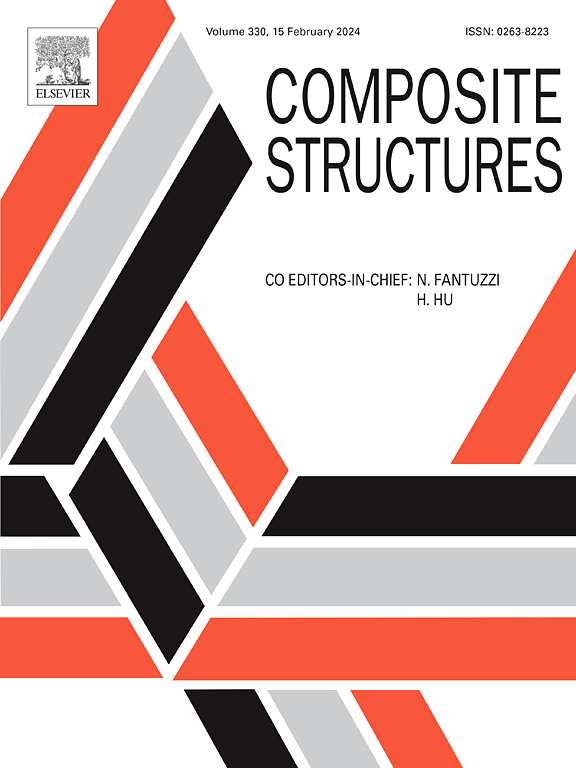Effects of grinding parameters on material failure mechanisms of 2D silicon carbide fiber-reinforced silicon carbide composites
IF 6.3
2区 材料科学
Q1 MATERIALS SCIENCE, COMPOSITES
引用次数: 0
Abstract
The Silicon Carbide Fiber-Reinforced Silicon Carbide (SiCf/SiC) composite is widely used in ultra-high-temperature applications due to its exceptional properties, but its brittleness makes machining, especially grinding, challenging. This study investigates the failure modes of fibers and the matrix during grinding of 2D SiCf/SiC composites under varying process parameters, such as wheel speed, feed rate, grinding depth, and surface structure. The results show that transverse fibers undergo ductile removal, shear fracture, bending fracture, and tensile fracture, while longitudinal fibers primarily experience ductile removal, tensile fracture, and bending fracture and normal fibers mainly exhibit shear and bending fractures. The matrix exhibits ductile, brittle, powdery, and peel-off removal modes. Grinding the woven surface (WS) leads to higher grinding forces and surface roughness than the stacking surface (SS), due to differences in fracture mechanisms. The primary material removal mechanisms of grinding wheel are friction wear and grit breakage, resulting from the high hardness of SiCf/SiC. Increasing wheel speed reduces both grinding force and surface roughness by promoting ductile removal, which is attributed to decreased undeformed chip thickness and enhanced strain toughness. The optimal grinding conditions are high wheel speed and sharp grit on the SS, yielding the best surface quality.
磨削参数对二维碳化硅纤维增强碳化硅复合材料失效机理的影响
碳化硅纤维增强碳化硅(SiCf/SiC)复合材料由于其特殊的性能被广泛应用于超高温应用,但其脆性使得加工,特别是磨削,具有挑战性。研究了在砂轮速度、进给速率、磨削深度和表面结构等不同工艺参数下,二维SiCf/SiC复合材料磨削过程中纤维和基体的破坏模式。结果表明:横向纤维主要发生韧性去除、剪切断裂、弯曲断裂和拉伸断裂,纵向纤维主要发生韧性去除、拉伸断裂和弯曲断裂,正常纤维主要发生剪切断裂和弯曲断裂。基体表现出延展性、脆性、粉末状和剥离去除模式。由于断裂机制的不同,对编织表面(WS)的磨削力和表面粗糙度要高于堆积表面(SS)。由于SiCf/SiC的高硬度,砂轮的主要去除机制是摩擦磨损和磨粒破碎。提高砂轮速度可以通过促进韧性去除来降低磨削力和表面粗糙度,这是由于减小了未变形的切屑厚度和提高了应变韧性。最佳的磨削条件是高砂轮速度和在SS上锋利的磨粒,产生最佳的表面质量。
本文章由计算机程序翻译,如有差异,请以英文原文为准。
求助全文
约1分钟内获得全文
求助全文
来源期刊

Composite Structures
工程技术-材料科学:复合
CiteScore
12.00
自引率
12.70%
发文量
1246
审稿时长
78 days
期刊介绍:
The past few decades have seen outstanding advances in the use of composite materials in structural applications. There can be little doubt that, within engineering circles, composites have revolutionised traditional design concepts and made possible an unparalleled range of new and exciting possibilities as viable materials for construction. Composite Structures, an International Journal, disseminates knowledge between users, manufacturers, designers and researchers involved in structures or structural components manufactured using composite materials.
The journal publishes papers which contribute to knowledge in the use of composite materials in engineering structures. Papers deal with design, research and development studies, experimental investigations, theoretical analysis and fabrication techniques relevant to the application of composites in load-bearing components for assemblies, ranging from individual components such as plates and shells to complete composite structures.
 求助内容:
求助内容: 应助结果提醒方式:
应助结果提醒方式:


